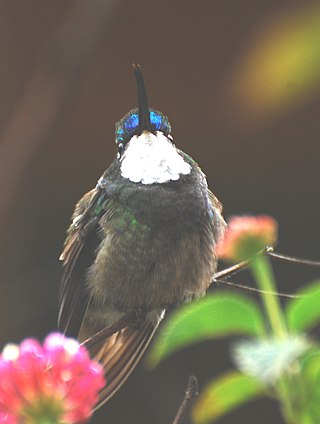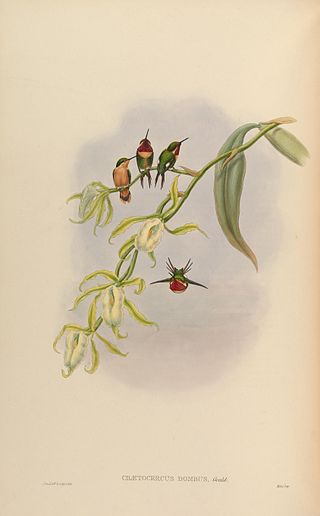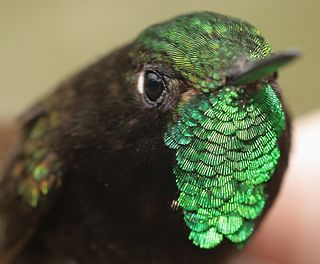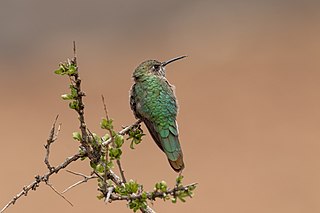
The grey-tailed mountaingem, also variously spelled gray-tailed mountaingem, grey-tailed mountain-gem, or gray-tailed mountain-gem, is a species of hummingbird in tribe Lampornithini of subfamily Trochilinae. It is endemic to Costa Rica.

The marvelous spatuletail is an endangered species of hummingbird in the "brilliants", tribe Heliantheini in subfamily Lesbiinae. It is endemic to northern Peru.

The tawny-bellied hermit is a species of hummingbird in the family Trochilidae. It is found in Colombia, Ecuador, and Peru.

The Esmeraldas woodstar is a rare, neotropical species of hummingbird in the family Trochilidae. There are six different species in the woodstar genus. Most of them are poorly studied due to their small size, extremely similar resemblance to each other, and rarity. Esmeraldas woodstars are one of the smallest bird species. They are sexually dimorphic. The main difference between sexes is that males have a bright purple throat. Esmeraldas woodstars are found only on the Pacific coast of west Ecuador in semi-deciduous to evergreen forests. They feed on the nectar of flowering shrubs and trees. The main threat to this species is deforestation. Esmeraldas woodstars are Vulnerable and require habitat protection.

The little woodstar, called estrellita chica in South America, is a Near Threatened species of hummingbird in tribe Mellisugini of subfamily Trochilinae, the "bee hummingbirds". It is found in Colombia, Ecuador and Peru.

The violet-bellied hummingbird is a species of hummingbird characterized by the male's shimmering violet belly.

The emerald-bellied puffleg is a species of hummingbird in the "brilliants", tribe Heliantheini in the subfamily Lesbiinae. It is found in Colombia, Ecuador, and Peru.

The Chilean woodstar is a Critically Endangered species of hummingbird in tribe Mellisugini of subfamily Trochilinae, the "bee hummingbirds". It is the only species placed in the genus Eulidia. It is endemic to Chile though there are unconfirmed reports from southern Peru. The species' name commemorates the English naturalist William Yarrell.

The Oaxaca hummingbird or blue-capped hummingbird is an endangered species of hummingbird in the "emeralds", tribe Trochilini of subfamily Trochilinae. It is endemic to the Mexican state of Oaxaca.

The black-bellied hummingbird is a species of hummingbird in the "emeralds", tribe Trochilini of subfamily Trochilinae. It is found in Costa Rica and Panama.

The scissor-tailed hummingbird is an Endangered species of hummingbird in the "mountain gems", tribe Lampornithini in subfamily Trochilinae. It is endemic to Venezuela.

The violet-headed hummingbird is a species of hummingbird in the family Trochilidae. It is the only species in the genus Klais.

The rufous-crested coquette is a species of hummingbird native to the tropical slopes of pacific South America. Due to its small size and population, it is a rare sight even within its native region. Males of the species can be easily distinguished by their striking rufous coloured spiked crests, and females, while less obvious, can be identified by their small size and rufous coloured foreheads.

The Perijá metaltail is an Endangered species of hummingbird in the "coquettes", tribe Lesbiini of subfamily Lesbiinae. It is found in Colombia and Venezuela.

The Peruvian piedtail, locally called Colibrí Colipinto Peruano, is a species of hummingbird in the "coquettes", tribe Lesbiini of subfamily Lesbiinae. It is endemic to Peru.

The bronze-tailed comet is a species of hummingbird in the "coquettes", tribe Lesbiini of subfamily Lesbiinae. It is endemic to Peru.

The glow-throated hummingbird is an Endangered species of hummingbird in tribe Mellisugini of subfamily Trochilinae, the "bee hummingbirds". It is endemic to a small area of Panama.

The grey-hooded sunbird is a species of bird in the family Nectariniidae. It is endemic to the Philippines. Its natural habitat is tropical moist montane forests.

The white-bellied cinclodes is a species of bird in the ovenbird family, Furnariidae. It is endemic to Peru where it inhabits high level, marshy grassland in the Junín Region and possibly also in the Huancavelica Region. This is a very large furnariid with dark upper parts and gleaming white underparts. It is a rare bird with very specific habitat requirements and is threatened by habitat destruction. The International Union for Conservation of Nature has assessed it as being "critically endangered".

The green-headed hillstar is a species of hummingbird found in the Andes of southern Ecuador and northern and central Peru. It is one of 6 species in the genus Oreotrochilus, and can be distinguished from its relatives by subtle differences in plumage coloration. The green-headed hillstar received its name due to its bronze and green crown and gorget of bright emerald green plumage. The species was first discovered by English ornithologist Osbert Salvin in 1895 and named after Polish ornithologist Jean Stanislaus Stolzmann.






















